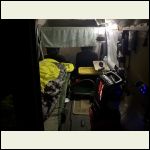|
| Author |
Message |
Jc55
Member
|
# Posted: 1 Apr 2024 06:36
Reply
Hello all,
This is my first post. I have an interesting one acre property I bought cheap on a dead end gravel road, not far from my house. It’s surrounded by ridges and it essentially gives me a large buffer because the neighbors don’t have access to “my side” of their property if that makes sense.
I had a small excavator dig a flat pad. They had to go down as much as 6’ into the side of a hill. It’s all clay, and there were big stones that had to be moved.
The plan is a 12x18 A-frame on 6x6” treated posts. As I dug the first two holes, there were massive stones just a foot down. At that point, soil disturbance and getting another excavator for ten holes wasn’t an option.
In Ohio, we have 100 year old corn cribs still standing on stones, so i decided to build on top of the ground. And figure I can shim the cabin as time progresses.
I spent a few weeks with my tractor, grading, packing, and drying out the clay(letting it settle). I used a transit.
I laid down landscape fabric, 6”+ of limestone (304s).
I modified a 55 gallon drum and poured ten, 22 1/2” piers(240 lbs each) with light rebar(fencing).
Using a transit, levels, string I placed each one and am letting them settle for a while then rechecking them in a couple of weeks.
Am I thinking right, given what I have to work with?
I’m sure it will move some, but should be fixable over time with a jack and some creativity.
The cabin will cantilever a foot over the piers, so the piers and ground below it should always stay dry.
First time building a cabin, and really want to do it all myself. I’m building it in my shop, then bringing it out as a kit.
Any pointers without changing the plan entirely? Thanks!
|
|
DaveBell
Moderator
|
# Posted: 1 Apr 2024 08:15
Reply
You don't need an A-frame in Ohio. How about a shed roof?
|
|
gcrank1
Member
|
# Posted: 1 Apr 2024 08:42 - Edited by: gcrank1
Reply
Ive done surface pads on sandy gravel ground with success; the biggest so far was 12x24 with a loft. I used the big solid cement silo staves. Your diy pads are waayyy better.
Use a piece of asphalt roofing shingle between any cement and wood.
Fwiw...When designing my 1st build I was attracted to the A-Frame. Im sure glad I didn't; the basic 'cube' shaped rooms are so much more livable. I had friends do, or buy A-Frames, and one who did a pyramid, and the corners at floor wall/roof became pretty much head-banging wasted space. They also make you live in a cave unless you put in dormer type windows (more complicated than typical wall windows.
Stand in a 12' wide space, figure how high the peak has to be so you can walk under the rafter depth without banging your head. You find your space is basically an isle down the center.
I suggest going with the 12x18 basic rectangle and a shed roof that you can complete the high side into a peaked roof over a deck later?
|
|
Jc55
Member
|
# Posted: 1 Apr 2024 09:27
Reply
Dave, don’t “need” it, but I want to build my dream. I used to draw A frames since I was 10 years old. I want to build something kind of over the top.
Gcrank1, whew! This is exactly what I wanted to hear! Thank you. The shingle is a great idea
|
|
gcrank1
Member
|
# Posted: 1 Apr 2024 10:17
Reply
Keep in mind that the whole roof load will be transferred directly to the floor outer rim so for A-Frames the cantilever idea is not good; the piers and deck should go full to the outside.
I designed and built a detailed model A-Frame in high school drafting class, pretty much what I thought Id do too. Between then and building about 11years later I learned a few things.
The A-Frame structure I ended up with after a more traditional cabin build was a doghouse.
|
|
ICC
Member
|
# Posted: 1 Apr 2024 18:31
Reply
I do agree with gcrank1's comments regarding A-frames. Especially with a small overall footprint you end up with a lot of fairly unusable floorspace if you are more than 3 feet tall. There is not much space where it is easy to hang a wall cabinet either. I would suggest giving some careful thought to an A-frame before committing 100% to building one.
But the question posed was about the foundation...
If you don't mind dealing with the possibility of releveling from time to time that could work for a part-time use cabin.
What size of beams down the long walls?
What size of floor joists are planned?
16 or 24" spacing?
Cantilevering a full foot is a bit too much, IMO. If the floor joists are 2x8, a max of 8" is regarded as maximum. As for whether or not an A-frame should be built on a cantilevered floor assembly it probably does not matter much as even with a conventional rectangular box structure with a gable roof, all the loads from the roof are transferred down to the same location. But a 12" cantilever should be reserved for 2x12 floor joists.
Also note that the two middle pads on the end walls are not needed if there is no center beam. The weight of the end walls can be carried on a doubled rim joist on each end. Roof loads will all be on the long walls and carried down to the concrete footers and the soil.
|
|
Jc55
Member
|
# Posted: 1 Apr 2024 18:51
Reply
Thank you all for the information! I appreciate it. All of it! I’m dead set on an a-frame. I’m building 4’ knee walls and it’ll be about 22’ tall with 2x8 rafters on 16” centers.
I camp on this property from time to time in a roof top tent, and take my tiny transit connect all over the country to camp, so a cabin would be an upgrade for occasional camping including a wood stove and partial loft. Tiny would be perfect for me.
The long runners on the piers will be 6x6 or steel I beams. On one wall, I’ll have another a-frame dormer.
I’ll be building a treated, 2x10 deck on 16” centers. I’ll have to run the costs on 12” floor joists. The reason I did center piers is to support a cultured stone entry way and a ridiculous medieval style Dutch door on one end.
|
|
gcrank1
Member
|
# Posted: 1 Apr 2024 19:08
Reply
I know what you mean about feeling it will be lots of room after what you have been used to. We did everything from on and under picnic tables to bivy to backpacking to motorcycle touring & camping. Then a short full size Ford van to an old canvas pop-up, a converted step-van tater chip truck and went really upscale to a new A-Liner Scout......
And somewhere in the middle of all that we hand built a 12x24 cabin mostly from salvaged wood from the 1897 barn on the farm. All that room was GLORIOUS! Ya can get spoilt or spoil yerself  LOL LOL
Rock On 
|
|
|
Jc55
Member
|
# Posted: 1 Apr 2024 19:26 - Edited by: Jc55
Reply
Sounds like you’re my type of person! This is what I’m usually used to, so yes, I’m really excited about a unique cabin!
IMG_5274.jpeg
| 
IMG_5628.jpeg
|  |  |
|
|
gcrank1
Member
|
# Posted: 1 Apr 2024 19:31
Reply
We have a Great crew here, lots of years of experience in lots of diff aspects of life. I can tell already you'll fit right in 
|
|
ICC
Member
|
# Posted: 1 Apr 2024 20:50 - Edited by: ICC
Reply
That appears to be the southwest US.
Quoting: Jc55 I’m building 4’ knee walls and it’ll be about 22’ tall with 2x8 rafters on 16” centers.
OK. Then it is not a true A-frame. A-frame rafters connect directly to the floor joist assembly to make a rigid triangle. What you describe is a gable roof cabin with longer than usual rafters and shorter than usual side walls.
It does seem that 22 feet is quite tall for a 12-foot-wide structure. Rough calculations indicate that with a 12 foot width and a height to the peak above the floor level of 18 feet, and 4-foot knee walls, the rafter length would be almost 19 feet (peak to wall top distance). The base angle of the rafter would be about 71.5 degrees, if I entered the numbers correctly. That comes out to be about a 36/12 pitch. Very steep.
Do you have a plan on how to apply the sheathing and then the shingles, metal panels or whatever?
One redeeming factor of a roof structure that steep is the horizontal loads, from the rafter tails to the wall tops is reduced. Reduced but not eliminated. There will still be a horizontal outwards push from the roof rafters to the wall tops. Rafter ties or ceiling joists on the top end of the vertical wall studs usually restrain those forces. 4-foot high walls would preclude their use.
The steep pitch reduces the rafter and roof weight horizontal force but the great area of the roof would mean that wind on either side of the roof will create great downward and outward forces on the opposite side, while simultaneously exerting a lifting force on the windward side. That's the theory... how that translates into real 60 mph winds is something for an engineer to calculate
|
|
Jc55
Member
|
# Posted: 1 Apr 2024 21:06
Reply
Quoting: gcrank1 We have a Great crew here, lots of years of experience in lots of diff aspects of life. I can tell already you'll fit right in
Thanks!
Thank you ICC. Yes. It will be ridiculous! I’m building it in my shop, then reassembling on site. I’ll be building the roof separate, battens, predrilling and labeling sheetmetal, dormer, eaves, everything. I have it drawn out somewhere. I may have miss spoke as my rafters are 2x8x16 and the height will include the deck being about 26” off the ground.
But, we’re not quite that far yet. My main concern was the foundation. I do plan on using screw in tie downs. It’s also surrounded by steep ridges. Although it will experience wind, it’s pretty well protected by the surrounding landscape
|
|
Aklogcabin
Member
|
# Posted: 2 Apr 2024 09:39
Reply
Congratulations Jc55 ! You have cabin fever. I kinda believe that folks should build what they want. You know exactly what you want. A good thing. Personally I like A frame looks. Lots of folks here will write that you shouldn't have an upper floor. We love the extra room and very happy with the design.
Build what you want, exactly. Or else you may end up looking back n saying to yourself, I should have done that. I'm confident that you have the ability to get it done. And I like your attitude
|
|
Jc55
Member
|
# Posted: 4 Apr 2024 06:11
Reply
Thank you! You get it!
|
|
paulz
Member
|
# Posted: 4 Apr 2024 08:34 - Edited by: paulz
Reply
Welcome Jc!
Foundation looks good to me, though I’m no expert. I used the same ‘concrete in the barrel’ method on my tractor port, though I dug holes in the ground and left the barrels in there. All good so far.
|
|
|

